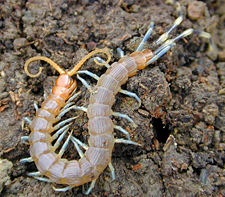Difference between revisions of "Centipede" - New World Encyclopedia
Katya Swarts (talk | contribs) |
Katya Swarts (talk | contribs) (Fixed taxobox) |
||
| Line 1: | Line 1: | ||
| − | {{ | + | |
| − | | color = pink | + | |
| − | | name = Centipedes | + | |
| − | | image = Centipede.jpg | + | {{Taxobox_begin | color = pink | name = Centipedes}} |
| − | | | + | {{Taxobox_image | image = [[Image:Centipede.jpg|225px|]] | caption = }} |
| − | | | + | {{Taxobox_begin_placement | color = pink}} |
| − | | | + | {{Taxobox_regnum_entry | taxon = [[Animal]]ia}} |
| − | | | + | {{Taxobox_phylum_entry | taxon = [[Arthropoda]]}} |
| − | | | + | {{Taxobox_subphylum_entry | taxon = [[Myriapoda]]}} |
| − | | | + | {{Taxobox_classis_entry | taxon = '''Chilopoda'''}}<br/>{{Taxobox authority | author = [[Pierre André Latreille|Latreille]] | date = 1817}} |
| − | | | + | {{Taxobox_end_placement}} |
| − | + | {{Taxobox_section_subdivision | color = pink | plural_taxon = [[Order (biology)|Orders]]}} | |
[[Geophilomorpha]]<br> | [[Geophilomorpha]]<br> | ||
| − | [[Lithobiomorpha]]<br> | + | [[Lithobiomorpha ]]<br> |
[[Scolopendrida]]<br> | [[Scolopendrida]]<br> | ||
| − | [[Scutigerida]] | + | [[Scutigerida]] |
| − | }}'''Centipedes''' (Class '''Chilopoda''') are fast-moving [[venom (poison)|venomous]], [[predator]]y terrestrial [[arthropod]]s that have long bodies and many [[arthropod leg|jointed legs]]. Chiefly [[nocturnal]], centipedes are found primarily in [[tropics|tropical]] climates but are also widely distributed in temperate zones. Some species are highly venomous with extremely toxic venom on their claws which can cause death in humans. | + | {{Taxobox_end}}'''Centipedes''' (Class '''Chilopoda''') are fast-moving [[venom (poison)|venomous]], [[predator]]y terrestrial [[arthropod]]s that have long bodies and many [[arthropod leg|jointed legs]]. Chiefly [[nocturnal]], centipedes are found primarily in [[tropics|tropical]] climates but are also widely distributed in temperate zones. Some species are highly venomous with extremely toxic venom on their claws which can cause death in humans. |
As in the closely-related [[millipede]]s, they are highly segmented (15 to 173 segments), but with only one pair of walking legs per segment. Centipedes are dorso-ventrally flattened, and are among the fastest and most agile of arthropod predators. | As in the closely-related [[millipede]]s, they are highly segmented (15 to 173 segments), but with only one pair of walking legs per segment. Centipedes are dorso-ventrally flattened, and are among the fastest and most agile of arthropod predators. | ||
Revision as of 12:41, 2 July 2006
| Centipedes | ||||||||
|---|---|---|---|---|---|---|---|---|
 | ||||||||
| Scientific classification | ||||||||
| ||||||||
| Orders | ||||||||
|
Geophilomorpha |
Centipedes (Class Chilopoda) are fast-moving venomous, predatory terrestrial arthropods that have long bodies and many jointed legs. Chiefly nocturnal, centipedes are found primarily in tropical climates but are also widely distributed in temperate zones. Some species are highly venomous with extremely toxic venom on their claws which can cause death in humans.
As in the closely-related millipedes, they are highly segmented (15 to 173 segments), but with only one pair of walking legs per segment. Centipedes are dorso-ventrally flattened, and are among the fastest and most agile of arthropod predators.
The head of a centipede has a pair of antennae and jaw-like mandibles, and other mouthparts that evolved from modified appendages. The most anterior trunk segment of a centipede has a pair of venomous claws (called maxillipeds) that are used for both defense and for capturing and paralyzing prey. Despite their name, which stems from the Latin words 'centum' (meaning 'hundred') and 'ped' (meaning 'foot'), they normally have around half that number of legs, though it is possible to find centipedes with over 200 legs.
The house centipede (Scutigera coleoptrata) is a fast-moving carnivore that feeds on insects such as cockroaches and other small invertebrates.
In Japanese mythology, heroes battle with giant centipedes, which even at mundane sizes are often thought to be connected with the world of the dead.
List of some commonly occurring centipedes
- Arizona desert centipede
- black centipede
- burrowing centipede
- Chinese red-headed centipede
- common centipede
- common desert centipede
- Egyptian centipede
- feather tail centipede
- garden centipede
- Galapagos Centipede
- giant bat-eating centipede
- giant desert centipede
- giant North American centipede
- giant peruvian centipede
- giant Sonoran centipede
- house centipede
- Megarian banded centipede
- orange footed centipede
- Peruvian giant orange leg centipede
- red feather tail centipede
- red-headed centipede
- stone centipede
- Sonoran desert centipede
- Tanzanian blue ringed centipede
- Vietnamese centipede
The giant orange leg centipede is the biggest centipede in the world, reaching 26 cm (10 in) in length. The prehistoric Euphoberia was four times bigger, still.
ReferencesISBN links support NWE through referral fees
- Neil A. Campbell, Biology: Fourth Edition, (Benjamin/Cummings Publishing, New York) 1996 page 614 ISBN 0-8053-1957-3
External links
- Tree of Life Project – Chilopoda
- What do you call a centipede?
- Pictures of many centipede species plus information
- Photos of Australian centipede (Scolopendra morsitans)
Credits
New World Encyclopedia writers and editors rewrote and completed the Wikipedia article in accordance with New World Encyclopedia standards. This article abides by terms of the Creative Commons CC-by-sa 3.0 License (CC-by-sa), which may be used and disseminated with proper attribution. Credit is due under the terms of this license that can reference both the New World Encyclopedia contributors and the selfless volunteer contributors of the Wikimedia Foundation. To cite this article click here for a list of acceptable citing formats.The history of earlier contributions by wikipedians is accessible to researchers here:
The history of this article since it was imported to New World Encyclopedia:
Note: Some restrictions may apply to use of individual images which are separately licensed.

